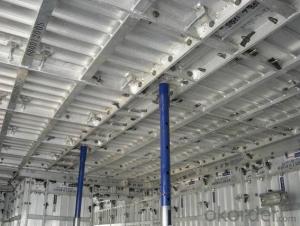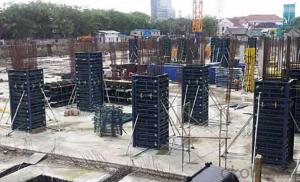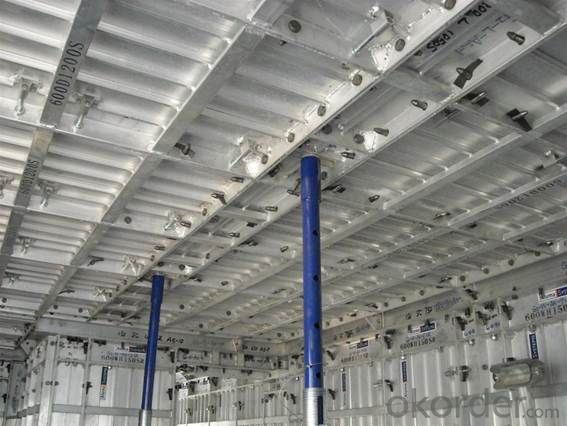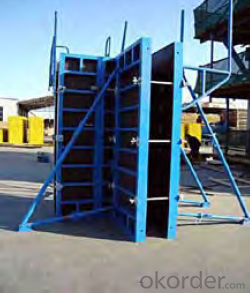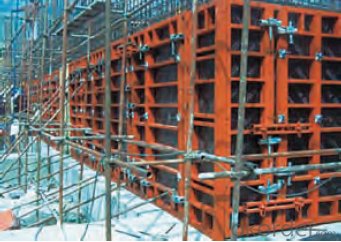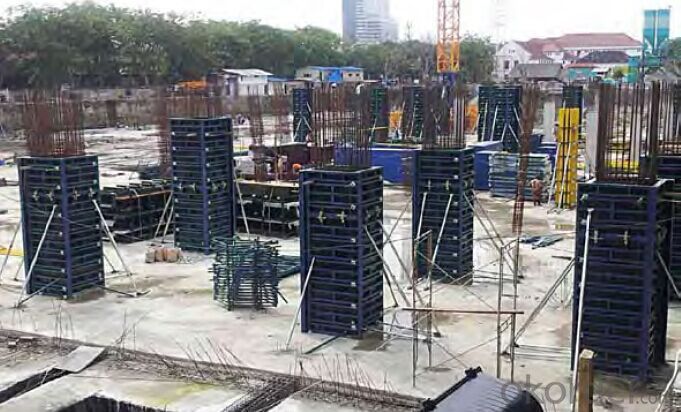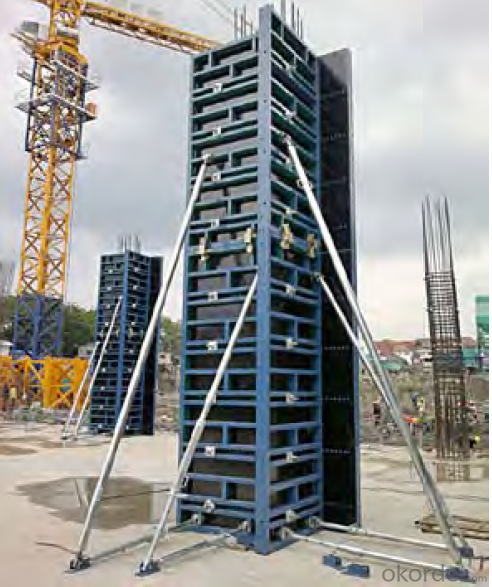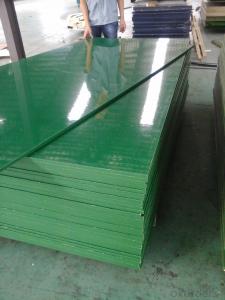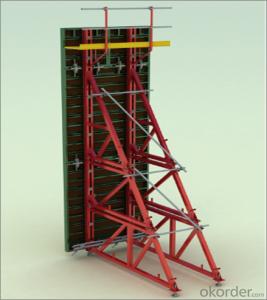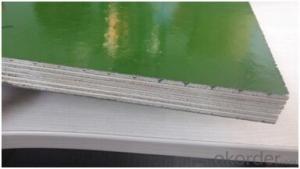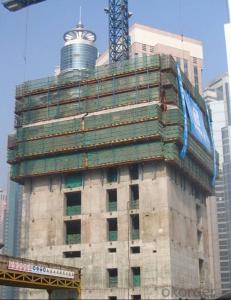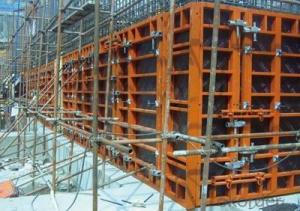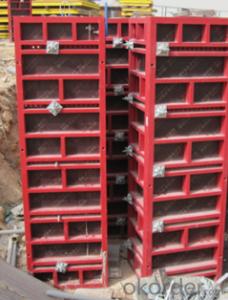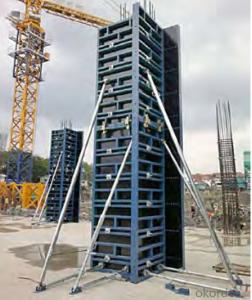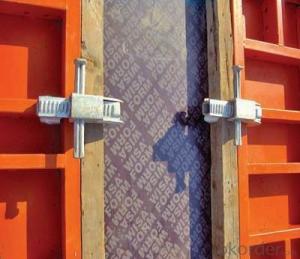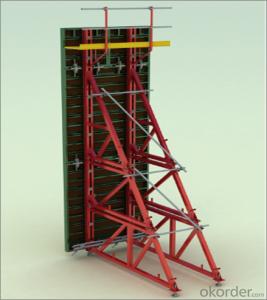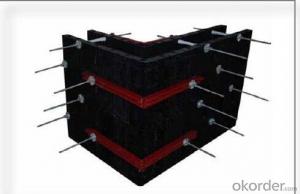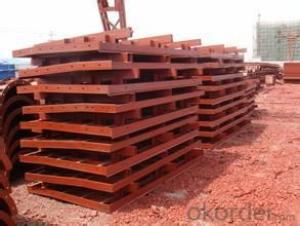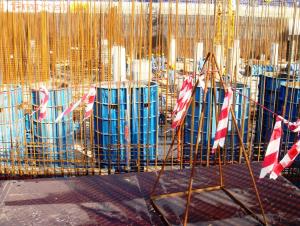Steel Frame Formwork with High Stiffness and No Assembling
- Loading Port:
- Shanghai
- Payment Terms:
- TT OR LC
- Min Order Qty:
- 1 m²
- Supply Capability:
- 100000000 m²/month
OKorder Service Pledge
OKorder Financial Service
You Might Also Like
1. Structure of Steel Frame Formwork GK120
There is a prizing part designed in the corner, which can help to position and remove formwork easily.
The plywood is screwed on from the back when connecting frame and plywood, so the surface of the finished concrete is perfect.
The formwork series are a complete system with a full set of accessories, and can be set up flexibly according to project demand.
2. Main Features of Steel Frame Formwork GK120
Light weight
High strength
High standardized system
Easy connection with adjustable steel clamp
Convenient and fast corner formwork
Flexible to assemble and application
3. Steel Frame Formwork GK120 Images
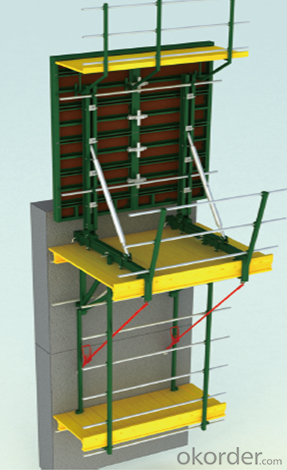
4. Steel Frame Formwork GK120 Specification
-The steel frame formwork is plywood covered with hollow steel. The plywood is 18 mm thick.
-The frame is highly strengthened, and the wall formwork can bear lateral pressure 60 KN/m2 while the column formwork can bear 80 KN/m2.
-As a standardized system, it is flexible to assemble , wood batten can be filled to satisfy the need f of non-standard size.
-The adjustable steel clamp is convenient to use, and can hold tightly.
-There is a prizing part designed in the corner, which can help to position and remove formwork easily.
-The plywood is screwed on from the back when connecting frame and plywood, so the surface of the finished concrete is perfect.
-The formwork series are a complete system with a full set of accessories, and can be set up flexibly according to project demand.
5. FAQ of Steel Frame Formwork GK120
1) What can we do for you?
.We can ensure the quality of the vinyl banner and avoid extra expenses for customers.
.We can provide you the professional design team.
.We can provide fashionable and newest styles for you.
.We can design the artwork for you.
. Please feel free to customize.
2) What promises can be done by us?
. If interested in Steel Frame Formwork GK120, please feel free to write us for any QUOTE.
. If printing required, please advise asap because the whole set need much more time to complete.
. Please DO check goods when courier knocks your door and contact us asap if any issue.
3) What about of our after-sale service?
. Response will be carried out in 24hours after receiving any complain or request.
. Steel Frame Formwork GK120 cost can be refund after order is confirmed.
. If the products are not based on the requirements, there will be the relevant compensations made for you.
4) What about the package and shipping time?
.Packing: As Customer's Requirements
.Shipping: We have various shipping ways for our customers, such as express which including TNT, DHL, FEDEX, UPS, EMS, etc. ; by air/ sea, and we are VIP of these express.
.Shipping time:
Normally small orders, it just 10-15 business days to arrive your hand; When comes to the customs declaration, it may need 7 days.
Other mass qty of Steel Frame Formwork GK120, we send them out by sea or by air to sea port or air port to save some shipping freight for our customers. By ocean, it may need 45~60days, by air, it may need 25~40days.
- Q: How does steel frame formwork handle concrete pouring and vibration?
- The effective handling of the concrete pouring and vibration process is achieved through the use of specially designed steel frame formwork. This formwork employs a rigid structure, acting as a support for the weight of the fresh concrete and facilitating the desired formwork configurations. To maintain stability and prevent any movement or displacement during concrete pouring, the steel frame formwork is securely fixed in position. This is essential for preserving the integrity and accuracy of the final structure. The steel frame offers a sturdy framework, enabling the smooth and efficient pouring of concrete. In terms of vibration, the steel frame formwork is engineered to withstand the forces generated during this process. Vibration is crucial for eliminating air pockets or voids within the concrete, ensuring a durable end product. By absorbing and distributing the vibration energy, the steel frame formwork prevents any deformation or damage to the structure. Furthermore, the steel frame formwork often incorporates additional features to enhance the concrete pouring and vibration process. These may include adjustable leveling devices, tie rods, and clamps, which provide extra support and stability. This allows for precise control over the pouring and vibration, resulting in a high-quality concrete structure. Overall, the steel frame formwork is specifically designed to handle the challenging conditions of concrete pouring and vibration. Its strong construction and advanced features offer the necessary strength, stability, and control required for a successful and efficient concrete construction process.
- Q: What are the different types of accessories available for steel frame formwork?
- The construction process requires various types of accessories for steel frame formwork, each serving a specific purpose. Some commonly used accessories include: 1. Wedges: These are essential for tightly securing the formwork panels together, ensuring a consistent and sturdy framework. 2. Clamps: To prevent any movement during concrete pouring, clamps are used to hold the formwork panels firmly in place. 3. Ties: Connecting the formwork panels to the structure being built, ties provide additional stability and support. 4. Brackets: At corners or intersections, brackets support the formwork panels, facilitating a seamless connection between different sections. 5. Struts: Vertically supporting the formwork panels, struts enhance strength and stability. 6. Anchors: Preventing any movement or displacement, anchors secure the formwork to the ground or other structures. 7. Release agents: These agents are applied to the formwork to prevent concrete from sticking to the panels, making removal easier once the concrete sets. 8. Formwork tape: To seal the joints between formwork panels and prevent concrete leakage during pouring, formwork tape is used. 9. Formwork oil: Applied to the formwork panels, formwork oil ensures a smooth and even surface, facilitating easy removal once the concrete sets. 10. Formwork accessories storage: Efficient storage systems are available to organize and store all the formwork accessories, enabling easy access and retrieval as needed. These accessories play a vital role in ensuring the stability, strength, and functionality of the steel frame formwork system, enabling efficient and safe construction processes.
- Q: What are the different types of climbing formwork systems used with steel frame formwork?
- There are several different types of climbing formwork systems that are commonly used with steel frame formwork in construction projects. These systems are designed to provide a safe and efficient method for constructing tall structures, such as high-rise buildings or bridges. 1. Hydraulic climbing formwork system: This type of climbing formwork system uses hydraulic power to lift and move the formwork upwards as the concrete is poured and cured. It is a versatile system that can be used for various types of structures and offers a high level of flexibility and adaptability. 2. Crane-jumped climbing formwork system: In this system, the formwork is lifted and moved vertically by a crane. It is typically used for larger structures where the hydraulic system may not be suitable. The crane-jumped system allows for quick and efficient construction, but it requires a crane on-site throughout the construction process. 3. Self-climbing formwork system: This system is designed to climb on its own without the need for external lifting equipment. It uses a series of jacks or hydraulic cylinders to lift and move the formwork. The self-climbing system is often used for repetitive construction tasks and can be easily adjusted to different heights and shapes. 4. Climbing protection screen system: This type of climbing formwork system is used in conjunction with the main formwork system to provide additional safety and protection to workers during construction. The climbing protection screen is installed on the outside of the formwork and prevents objects or debris from falling off the structure. These climbing formwork systems offer various advantages, such as increased productivity, enhanced safety, and reduced labor costs. They are designed to streamline the construction process and ensure that tall structures are built efficiently and securely. The choice of the climbing formwork system depends on factors such as the size and complexity of the structure, the construction timeline, and the available resources and equipment.
- Q: How does steel frame formwork handle different types of concrete mixes?
- Steel frame formwork is highly versatile and capable of handling different types of concrete mixes effectively. Its robust and sturdy construction ensures it can withstand the pressure and weight of various concrete compositions, including high-strength mixes. The steel framework provides excellent support and stability during the pouring and curing process, ensuring the concrete retains its desired shape and strength. Furthermore, steel frame formwork offers flexibility in adjusting the formwork to accommodate different concrete mixes, allowing for precise construction and customization.
- Q: What are the common safety training requirements for using steel frame formwork systems?
- The common safety training requirements for using steel frame formwork systems include: 1. Proper understanding of the equipment: Users should be trained on the correct assembly, disassembly, and operation of the steel frame formwork systems. This includes knowing the different components, their purpose, and how they fit together. 2. Personal protective equipment (PPE): Trainees should be educated on the importance of wearing appropriate PPE such as hard hats, safety goggles, gloves, and steel-toed boots. They should understand how to properly use, maintain, and inspect their PPE to ensure its effectiveness. 3. Fall protection: Falling from heights is a significant risk when working with steel frame formwork systems. Safety training should cover the use of fall protection equipment such as harnesses, lanyards, and anchor points. Users should be trained on how to properly set up and use these systems to prevent falls. 4. Load capacity and weight limits: Steel frame formwork systems have specific load capacity and weight limits that must be adhered to. Training should focus on understanding these limits and how to calculate and distribute loads safely. Users should be aware of the risks associated with overloading and how it can compromise the stability and safety of the structure. 5. Proper handling and storage: Training should cover the correct methods for handling and storing steel frame formwork components. This includes techniques for lifting, moving, and securing the equipment to prevent accidents and damage. Users should also be educated on how to store the components to maintain their structural integrity and prevent rust or deterioration. 6. Hazard identification and mitigation: Safety training should emphasize the importance of identifying potential hazards on the construction site and implementing measures to mitigate them. Users should be trained to recognize and address hazards such as uneven ground, overhead obstructions, electrical hazards, and inclement weather conditions. 7. Emergency procedures: Trainees should be familiarized with emergency procedures, including evacuation plans, first aid, and reporting protocols. They should understand how to respond to accidents, injuries, or equipment failures and know how to communicate effectively in case of an emergency. Overall, safety training for using steel frame formwork systems is crucial to ensure the well-being of workers and the successful completion of construction projects. It is essential to provide comprehensive training that covers all potential risks and equips users with the knowledge and skills to work safely and efficiently with these systems.
- Q: Can steel frame formwork be used in projects with restricted construction budgets?
- Yes, steel frame formwork can be used in projects with restricted construction budgets. While steel frame formwork may initially have a higher upfront cost compared to other formwork materials, it offers several advantages that can result in cost savings in the long run. Steel formwork is highly durable, reusable, and requires less maintenance, reducing the need for frequent replacements or repairs. Additionally, it provides a smooth and accurate finish, minimizing the need for additional finishing work, thus saving both time and money. Overall, the cost-effectiveness and long-term benefits of steel frame formwork make it a viable option for projects with restricted construction budgets.
- Q: Can steel frame formwork be used for industrial structures?
- Certainly! Industrial structures can indeed utilize steel frame formwork. This system, known for its versatility and durability, offers a multitude of advantages when it comes to constructing such buildings. To begin with, steel frame formwork boasts exceptional strength and rigidity. Consequently, it is well-suited for supporting heavy loads and enduring the typical forces encountered in industrial construction. As a result, it becomes a dependable option for erecting expansive industrial edifices like warehouses, factories, and power plants. Furthermore, steel frame formwork presents an elevated level of customization and flexibility. It can be easily adjusted and modified to accommodate various shapes and sizes, thereby enabling the construction of intricate industrial structures with diverse configurations. This adaptability proves particularly invaluable in industrial environments where unique designs and layouts may be necessary. Moreover, steel frame formwork demonstrates remarkable durability and longevity. It can endure harsh environmental conditions, including extreme temperatures, moisture, and exposure to chemicals. This durability ensures that industrial structures constructed using steel frame formwork will have a prolonged lifespan and require minimal maintenance over time. Additionally, steel frame formwork facilitates efficient and rapid construction. Thanks to its modular nature and ease of assembly, it enables faster construction times, ultimately reducing the overall project duration. This becomes crucial in industrial construction, where time often plays a critical role. Finally, it is worth mentioning that steel frame formwork can be effortlessly disassembled and reused. This sustainability aspect makes it an environmentally friendly choice for industrial construction, as it minimizes waste and promotes resource efficiency. In conclusion, steel frame formwork proves to be a suitable option for industrial structures due to its strength, customization capabilities, durability, efficiency, and sustainability. It offers a reliable and cost-effective solution for the construction of sturdy and adaptable industrial buildings.
- Q: How does steel frame formwork help in achieving accurate concrete leveling?
- Steel frame formwork helps in achieving accurate concrete leveling by providing a rigid and stable structure for pouring and shaping the concrete. The steel frames are designed to be strong and durable, ensuring that they maintain their shape and alignment throughout the entire concrete pouring process. One of the main advantages of using steel frame formwork is that it allows for precise control of the concrete placement and leveling. The frames can be easily adjusted and aligned to the desired height and slope, ensuring that the concrete is poured at the correct level. This helps to eliminate any inconsistencies or unevenness in the finished concrete surface. Additionally, steel frame formwork provides excellent support and stability, preventing any deformation or movement of the formwork during the pouring and curing of the concrete. This ensures that the concrete maintains its intended shape and level, even under the pressure of the wet mix and the weight of the concrete itself. The steel frames also help to minimize the risk of concrete shrinkage and settlement, which can occur if the formwork is not properly supported. By providing a strong and rigid structure, the steel frames help to distribute the weight of the concrete evenly, reducing the chances of any sinking or settling after the concrete has cured. Furthermore, steel frame formwork is highly versatile and can be easily customized to fit different shapes and sizes of concrete structures. This allows for accurate leveling even in complex and irregular concrete designs. In conclusion, steel frame formwork plays a crucial role in achieving accurate concrete leveling by providing a stable and adjustable structure for pouring and shaping the concrete. Its strength, stability, and versatility ensure that the concrete maintains its desired level and shape, resulting in a high-quality and level finished surface.
- Q: What are the different types of concrete release agents used with steel frame formwork?
- There are several different types of concrete release agents that can be used with steel frame formwork. These release agents are applied to the surface of the formwork to prevent the concrete from sticking to it during the pouring and curing process. One common type of release agent is a petroleum-based product. These agents are typically oil-based and provide a barrier between the formwork and the concrete. They are easy to apply and provide a smooth release, allowing for easy removal of the formwork once the concrete has cured. However, petroleum-based release agents can be flammable and may have a negative impact on the environment. Another type of concrete release agent is a water-based product. These agents are typically made from a combination of water, surfactants, and other additives. They are non-toxic and environmentally friendly, making them a popular choice for many contractors. Water-based release agents are easy to apply and provide a clean release, leaving little or no residue on the formwork. There are also specialty release agents available for specific applications. For example, some release agents are designed to provide a textured finish on the concrete surface, while others are formulated for use with colored or decorative concrete. These specialty agents can help achieve specific desired finishes or appearances. In addition to the different types of release agents, there are also different forms in which they can be applied. Some release agents come in liquid form, which can be sprayed or brushed onto the formwork. Others come in the form of a release agent film or tape, which can be applied directly to the formwork surface. The choice of application method will depend on the specific requirements of the project and the preferences of the contractor. Overall, the different types of concrete release agents used with steel frame formwork offer a range of options to ensure easy and efficient removal of the formwork and a smooth, clean finish on the concrete surface. Contractors should consider factors such as environmental impact, ease of application, and desired finish when selecting the appropriate release agent for their project.
- Q: Can steel frame formwork be used for pre-stressed or post-tensioned concrete structures?
- Using steel frame formwork for pre-stressed or post-tensioned concrete structures is not possible. Specialized formwork systems are necessary to handle the intense tension forces that arise from pre-stressing or post-tensioning. Steel frame formwork is not built to withstand these forces and could fail, potentially causing the structure to collapse. To guarantee the safety and reliability of the construction project, it is crucial to employ formwork systems specifically engineered and designed for pre-stressed or post-tensioned concrete structures.
Send your message to us
Steel Frame Formwork with High Stiffness and No Assembling
- Loading Port:
- Shanghai
- Payment Terms:
- TT OR LC
- Min Order Qty:
- 1 m²
- Supply Capability:
- 100000000 m²/month
OKorder Service Pledge
OKorder Financial Service
Similar products
Hot products
Hot Searches
Related keywords
